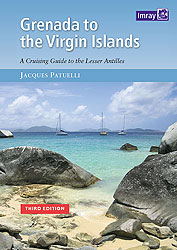| |
|

Martinique, for Europeans synonymous with creole, beguine and punch, has a colourful and dramatic past which has influenced the whole Caribbean.
Christopher Columbus discovered the island in 1502, giving it a name almost certainly of Carib origin: Madinina, the Island of Flowers. In June 1635 the Frenchmen Lienard de l’Olive and Duplessis d’Ossonville reached St Christophe, but were quickly put off by those redoubtable allies of the savage Caribs, the fer-de-lance snakes. Some months later the rather bolder Belain d’Esnambuc founded Fort St Pierre, beginning a line of excellent governors, amongst them his nephew du Parquet. The latter bought the whole island, which he kept until he died in 1676. After several Dutch and English attempts to conquer Martinique, it was made part of the kingdom of France in 1676, an alliance also due in part to feminine charms. Madame de Maintenon, brought up at Le Prêcheur in the N part of the island, knew very well how to get the king (Louis XIV) interested in so small a territory. Later the Empress Joséphine had to use the same feminine approach with Napoléon Bonaparte.
In 1762 the English conquered the island. By the terms of the Treaty of Paris (1763), France had to sacrifice Canada, ‘a few acres of snow’, to get back ‘the Isle of Flowers’. In the same year Joséphine Tascher de la Pagerie, the future empress, was born. A few months earlier and she would have been born English!
In 1794, worried by the Revolution, the powerful landowner Dubuc, with some other colonists, helped the English return. Napoléon recovered the island in 1802 in order to re-establish slavery as in Guadeloupe, but lost it again in 1809, the same year in which he repudiated Joséphine. A second Treaty of Paris in 1814 definitively returned Martinique to its first occupants.
|
|
|
|
Since the end of the 17th century sugar cane cultivation had grown considerably with the regrettable consequence of the importing of African slaves. By the end of the 18th century this practice had completely changed the ethnic composition of Martinique, as with all the sugar islands, such that the vast majority of the population had become of African stock.
St Pierre, the first town and the economic centre, was literally razed in 1902 by the eruption of Mont Pelée. This terrible catastrophe caused 30,000 deaths and utterly changed the economic and social situation of Martinique because the majority of the European population died in the eruption.
Although 7000km from the French capital, the Isle of Flowers became a French department Département d’Outre Mer Overseas Department or DOM in 1946. The status gave the island advantages by way of subsidies which, as with Guadeloupe, raised its standard of living appreciably above that of neighbouring islands. All the same, despite these cultural and historical links between France and its American islands, the distance from the capital, the difference in ways of life and customs and the ethnic diversity have often hindered integration with France.
The population is densely packed (350 people per sq km), 90% black and mixed race with several thousand Hindus and Syrio-Lebanese. Although proportionally few, thanks to their history and social position the 4000 or so ‘Békés’ (descendents of old Creole roots) are still influential. There are also several thousand civil servants and private citizens from metropolitan France who have usually lived in the island for several years.
In economic terms Martinique is still largely dependent on agriculture (sugar, bananas and pineapples), although for some years now considerable emphasis has been put on developing tourism both at sea and ashore.
|
|
|





